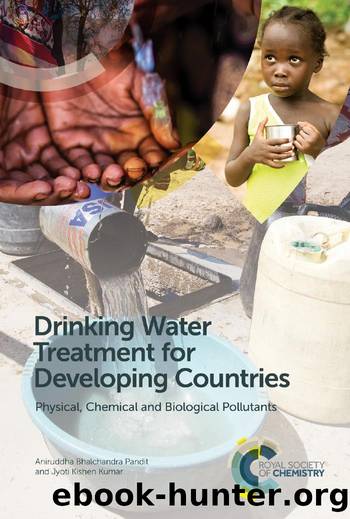Drinking Water Treatment for Developing Countries by Pandit Aniruddha Bhalchandra;Kumar Jyoti Kishen; & Jyoti Kishen Kumar

Author:Pandit, Aniruddha Bhalchandra;Kumar, Jyoti Kishen; & Jyoti Kishen Kumar [Неизв.]
Language: eng
Format: epub
ISBN: 9781788017626
Publisher: Book Network Int'l Limited trading as NBN International (NBNi)
Published: 2019-03-03T21:00:00+00:00
3.6.3 Ultraviolet Irradiation
Irradiation with UV systems is yet another method of disinfection that has been used as it is easy to install and economical to operate and maintain. In recent years, there has been a renewed interest in UV systems for water disinfection due to their ability to inactivate (>99.9%) chlorine resistant protozoans, Giardia lamblia cysts and Cryptosporidium parvum oocycts. Generally, a 16 mJ dose of UV is sufficient for disinfection of non-pathogenic organisms. However, for inactivation of Giardia and Cryptosporidium, a minimum dose of 40 mJ is required. However, for UV systems to function, water must have low turbidity to enable UV penetration and microbial deactivation.18 Therefore, these lamps need periodic cleaning, especially if placed in a submerged configuration. Due to their finite life span, they must be periodically replaced. Further research on the use of UV for treating harvested rain water has led scientists to investigate the ability of UV to treat micropollutants in rain water.
It has been reported that a VacuumâUV (VUV) process is a promising advanced treatment of rain water due to its high efficiency, easy installation and safe rain water reuse. VUV is an emerging technique and is based on advance oxidation processes (AOPs). It works by generating HOË by photoionization of water molecules after absorbing photons having short wavelengths, e.g., 185 nm. Most importantly, this process does not require the addition of extra oxidants and thus their subsequent removal. Li et al., in 2015, reported the first such study where six micropollutants including phenols and recalcitrant aromatics in harvested rain water were successfully treated with VUV.19
Download
This site does not store any files on its server. We only index and link to content provided by other sites. Please contact the content providers to delete copyright contents if any and email us, we'll remove relevant links or contents immediately.
| Automotive | Engineering |
| Transportation |
Whiskies Galore by Ian Buxton(40326)
Introduction to Aircraft Design (Cambridge Aerospace Series) by John P. Fielding(32337)
Small Unmanned Fixed-wing Aircraft Design by Andrew J. Keane Andras Sobester James P. Scanlan & András Sóbester & James P. Scanlan(32141)
Craft Beer for the Homebrewer by Michael Agnew(17445)
Turbulence by E. J. Noyes(7037)
The Complete Stick Figure Physics Tutorials by Allen Sarah(6637)
Kaplan MCAT General Chemistry Review by Kaplan(6053)
The Thirst by Nesbo Jo(5783)
Bad Blood by John Carreyrou(5767)
Learning SQL by Alan Beaulieu(5407)
Weapons of Math Destruction by Cathy O'Neil(5034)
Man-made Catastrophes and Risk Information Concealment by Dmitry Chernov & Didier Sornette(4734)
iGen by Jean M. Twenge(4702)
Digital Minimalism by Cal Newport;(4529)
Life 3.0: Being Human in the Age of Artificial Intelligence by Tegmark Max(4502)
Audition by Ryu Murakami(4097)
1,001 ASVAB Practice Questions For Dummies by Powers Rod(4038)
Electronic Devices & Circuits by Jacob Millman & Christos C. Halkias(4024)
Pale Blue Dot by Carl Sagan(4001)
